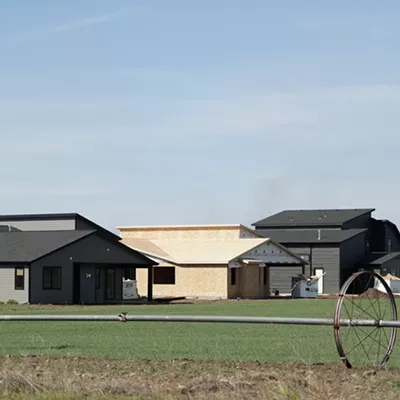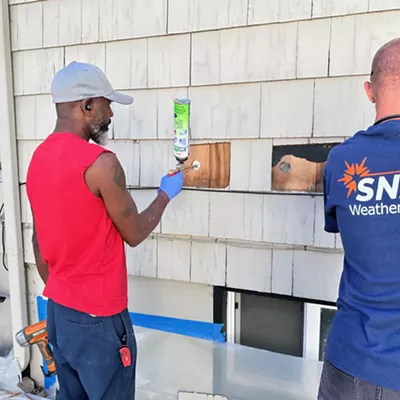My friend Wayne is the kind of guy who asks provocative questions. Over a sandwich one day, he asked, "Who do you suppose came up with the idea to grind up wheat and add yeast to make bread?"
Since my mouth was full, I couldn't come back with a smart-ass answer like I usually do, so I actually thought about it. Bread is an ancient food, a staple in all cultures and a metaphor for life in many spiritual traditions. Anyone who has baked bread from scratch knows how easy it is to turn all meditative and poetic while describing the process. But pretty words alone wouldn't answer Wayne's question.
The earliest bread-bakers first had to recognize that certain grasses contained edible kernels, I realized. Of course, the grains aren't edible in their raw state, so they had to learn that soaking and grinding could make a basic cereal mush. Perhaps someone dropped a glob of mush onto a hot rock one day and figured out the basics of flatbread, a more palatable and portable form of cereal. But that's still a long way from a sandwich.
While pondering the origins of bread, I bumped into my friend and fellow Inlander denizen, Marty Demarest. Turns out Marty was way ahead of me in the research department, as usual. He's been experimenting with breads, especially sourdough, since last fall. He told me that he had captured his own wild yeast and happily nurtured a living sourdough culture, which he offered to share with me. I shook off the visions of Marty wielding something like a microscopic butterfly net and promptly agreed to try my hand at sourdough. By working with homegrown leavening, I thought, perhaps I could get to the heart of the mystery.
To a suburban kid like me, fresh-baked bread usually meant a trip to the local bakery. On those rare occasions when I ventured into the world of yeast breads, it was with a trusty packet of Fleischman's active dry yeast in one hand and lots of trepidation in the other. There was the time in the 10th grade when my friend Angela and I decided to bake baguettes for our entire French class. The reason escapes me now, but with a total of four ingredients -- flour, water, yeast and salt -- we thought, how hard could it be? Turns out it was hard enough to dent a desk, although once we chiseled our way through the crust, the bread inside was pretty tasty.
Later, I learned some secrets of the bread craft from a wandering minstrel who worked in bakeries from Colorado to New Hampshire. I went through a short-lived phase of churning out hearty whole-grain loaves in the midst of a New England winter but quit once the weather turned warm. Since then, my bread-baking skills have lain dormant -- like dry yeast, if you will.
To get to the bottom of "The Great Bread Question," first I consulted the literature. I stumbled upon Bread Made Easy by Beth Hensperger, a sort of "Bread for Dummies" manual with great glossy photos. I eased back into la boulangerie with a basic white bread from her collection. Using warm milk and nothing fancier than unbleached, all-purpose flour and packaged dry yeast, I created two lovely, golden brown loaves. The bread had a creamy color and uniform crumb, perfect for toast or sandwiches or for simply slathering with butter while still warm.
Working with the dough brought back to me the notion that baking bread is not like baking cookies. Bread dough is a living, breathing thing. In kneading, I impart some of my own life energy to the dough, coaxing it to grow and change. The basic white bread was a good start, but using commercial yeast felt somehow like bread with training wheels. I knew I was still a few steps away from the ancient rites of risen bread. It was time to tackle sourdough.
Marty handed me a large covered Tupperware bowl containing about two cups of bubbly liquid the consistency of pancake batter. "Now, you have to feed it three times a day," he told me. "Two cups of flour and two cups of warm water now, then four cups of each tonight. Stir it up, cover it, and let it sit on the kitchen counter. This culture is almost ready to go; by tomorrow, you should be able to bake."
I cradled the bowl for the trip to its new home. I felt like I had just adopted some kind of exotic pet. I fed it and watered it on schedule, and it rewarded me by growing so big that I had to borrow a larger bowl from my neighbor to keep it from taking over the counter.
The next day, I assembled my sourdough according to the proportions outlined by Nancy Silverton in her book, Breads From the La Brea Bakery. (The book is encyclopedic on the creation of sourdough breads, although perhaps overwhelming for the casual reader; another good reference is Classic Sourdoughs by Ed Wood of Idaho.) The dough felt a bit more sticky than the earlier white bread, a tad wilder and harder to handle. Because the yeast in sourdough isn't cultivated for maximum performance, rising takes longer. After the initial mixing and kneading, the dough rested for 20 minutes; following more kneading, it then rose at room temperature for about four hours. I punched it down and slapped it around, then let it rest again. Next I shaped it into two round loaves and set it out to rise again. After a couple more hours, it was ready to bake.
I placed my new baking stone on the bottom rack of the oven and set the temperature to incinerate (actually 500 degrees). When the oven reached peak heat, I opened the door and spritzed the interior with water to simulate the steam injection of commercial ovens. With great difficulty, some finesse, and a few choice words, I slid the first loaf onto the stone without singeing my eyebrows. Two more spritzes in the first five minutes of baking set the humidity level, and I knocked the heat back to 450 degrees.
Then came the waiting. Forty-five minutes later, a slightly misshapen but beautifully crusty loaf emerged. The steaming interior held a wonderfully random pattern of bubbles and the traditionally chewy texture of sourdough. This native Spokane sourdough wasn't too sour, but a hint of tang lingered on the tongue.
So, Wayne, there you have it. A little bit of flour, some water, some warmth, a touch of luck, and the sharing of good friends -- that's what led to bread. A purely rational person may see only biochemistry at work, but I like to think I've tapped into the mystique that has put bread at the center of human culture and spirituality for generations.
More in this issue: http://www.inlander.com/food/291854448063046.php
Publication date: 06/03/04
















